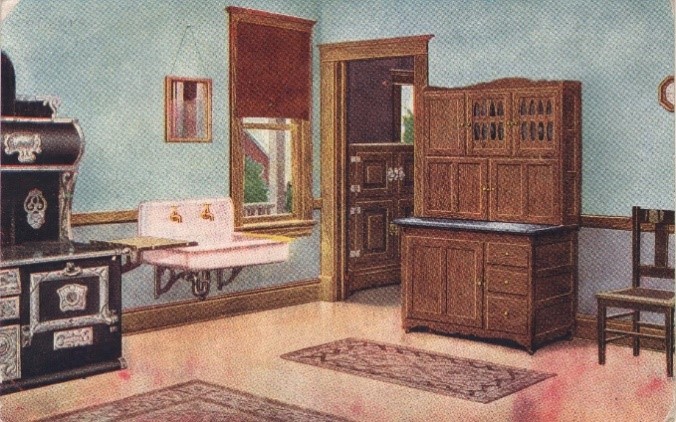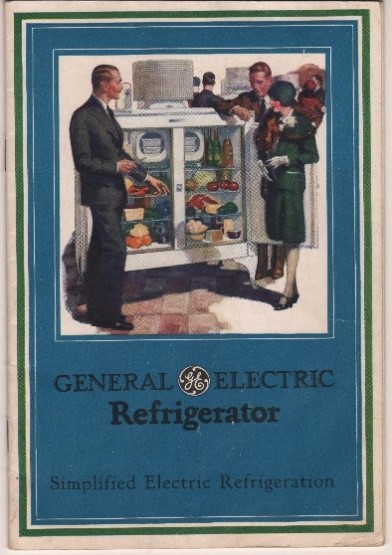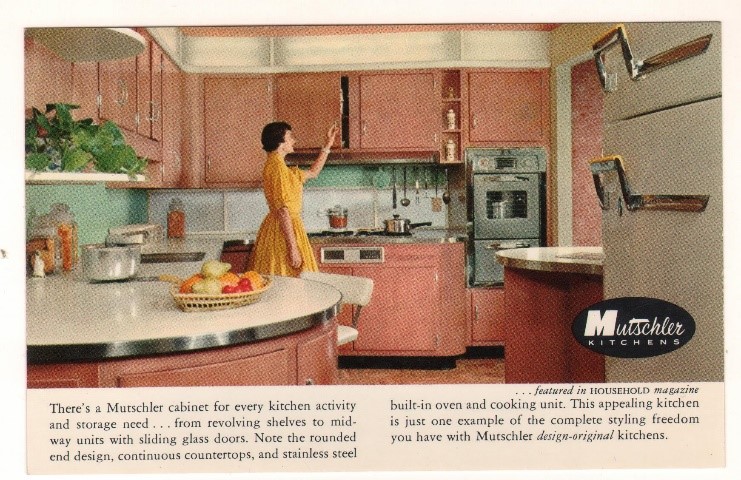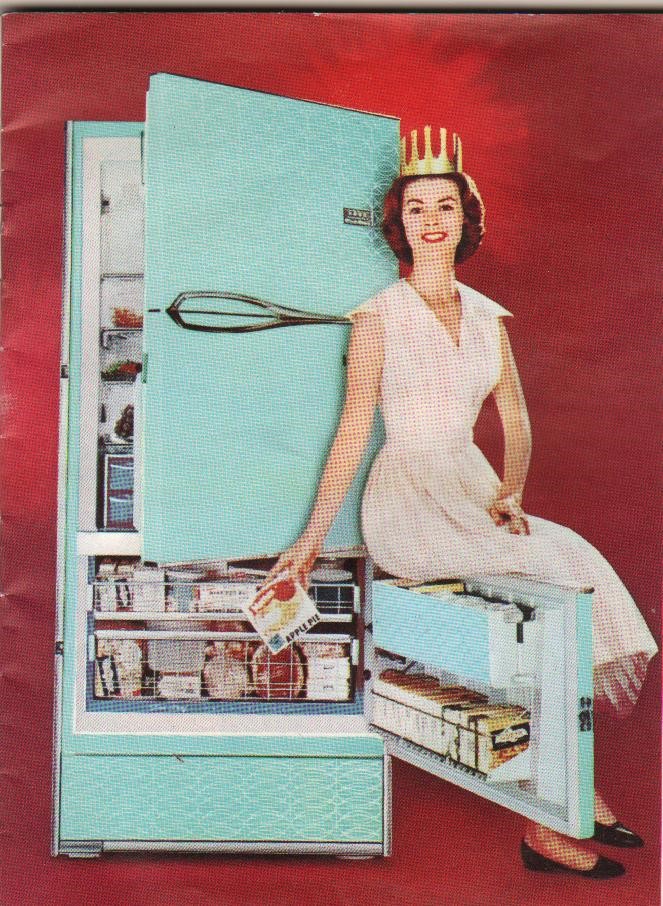Carol Mobley
Electricity Makes Women Free
Nothing has changed the modern kitchen more than the introduction of electricity. The early 1900s kitchen had the ice box on the back porch and wood stove in the kitchen. With electricity the refrigerator was moved inside the kitchen and it became the focal point instead of the stove. By 1930 Westinghouse Electric boasted that “electricity makes women free.”
Advertising postcard for J.T. Clough Furniture, Greeley, Colorado
A 1912 postcard illustrating the modern kitchen with the sanitary and biggest ice-saving refrigerator (ice box). Notice the location on the back porch away from the inside heat of the wood cook stove. Also notice the freestanding sink and the only cupboard being the Hoosier.
The first household refrigerator was available in 1913. But it wasn’t until General Motors (GM) purchased Guardian Frigerator Company in 1918 that we saw mass production of electric refrigerators. Appliance companies copied the assembly lines established by the automobile industry. Not to be outdone, General Electric boasted that they had 64 skilled engineers working since 1913 to create “an electric refrigerator so efficient, so simplified that it could literally be installed and forgotten.” Forget until it needed to be moved! The compressor was mounted on top of the unit and most refrigerators weighed between 180 pounds and 360 pounds depending on the make and model. Refrigerators and kitchen cabinets of the time all had open legs at the bottom, perhaps to allow for ease of cleaning underneath. The open-leg design on refrigerators had to change just because of the weight of the appliance. Frequently the legs would fail when someone tried to move the appliance.
1928 General Electric Refrigerator sales booklet
GE and Frigidaire were the two biggest names in home refrigeration. Kitchen design revolved around the refrigerator. This Westinghouse brochure considers kitchen efficiency in meal preparation or how to take the least amount of steps from pantry to table.
1930s Westinghouse Electric brochure on kitchen design
By the end of World War II, companies like Westinghouse, Youngstown Kitchens, Mutschler Kitchens and Mengel Royal Wood Kitchens advertised designing your dream kitchen. Postcards and booklets were readily available for the homeowner as a way to encourage households to upgrade their kitchens. The modern kitchen with all electric appliances not only saved a woman time but provided safe and sanitary food storage. By 1944, 85% of all households had a refrigerator. Small freezer units were now included which allowed the storage of frozen goods and making of ice, something never before capable in the home setting.
Notice by now that the compressors were moved off the top of the refrigerator. Another design change was the introduction of factory made cabinets that mounted to the walls and sealed the cabinet to the floor. By now the kitchen sink was incorporated into the cabinet along side an electric dishwasher. These cabinets were available in both wood and metal. Most kitchen plumbing was not as water tight as today which made for problems with wood rot and rust underneath the sink.
Late 1950s advertising postcard for Pierson & Roth kitchen
Then in the late 1950s something wonderful happened to the refrigerator. Americans lived in the land of plenty. Cars were as big as boats with huge chrome bumpers and tail fins. The design of the refrigerator door illustrates the abundance in American households. Large chrome handles, unusual colors and larger capacity refrigerators began replacing the simple 1920s and 1930s plain white models. The ultra-modern kitchen had a refrigerator that was incorporated into the cabinets so that each cabinet held different types of foods at different temperatures. This kitchen was clutter free, no appliances on the counter, only the fittings to mount the blender or mixer that was stored below. Other conveniences were added to the refrigerator like larger freezers, more interior capacity, self-defrosters, and automatic ice-makers.
Refrigerator with chrome handles
1958 advertising postcard for Mutschler Kitchens, Denver distributor
“Feel like a queen in your kitchen”
1959 Advertising brochure for Frigidaire Home Appliances
And so the modern kitchen was born. Electricity is indispensable not only for the refrigerator but for the dozens of small appliances designed to make food preparation easier. Kitchen appliances came with operating manuals that most women kept with their cookbooks since recipes were included. Postcards and brochures are how companies let the public know what was available. People collected these ephemeral items and it has helped document changes to the American kitchen. And now, the stove with the large vent hood or microwave oven has regained it’s prominence in the kitchen but not replacing the refrigerator but complimenting the overall look of a well designed kitchen.






My dad (born in 1934) still calls an electric refrigerator an “icebox”!
Thanks for a great article. I love the images too!
Great article… love the pictures